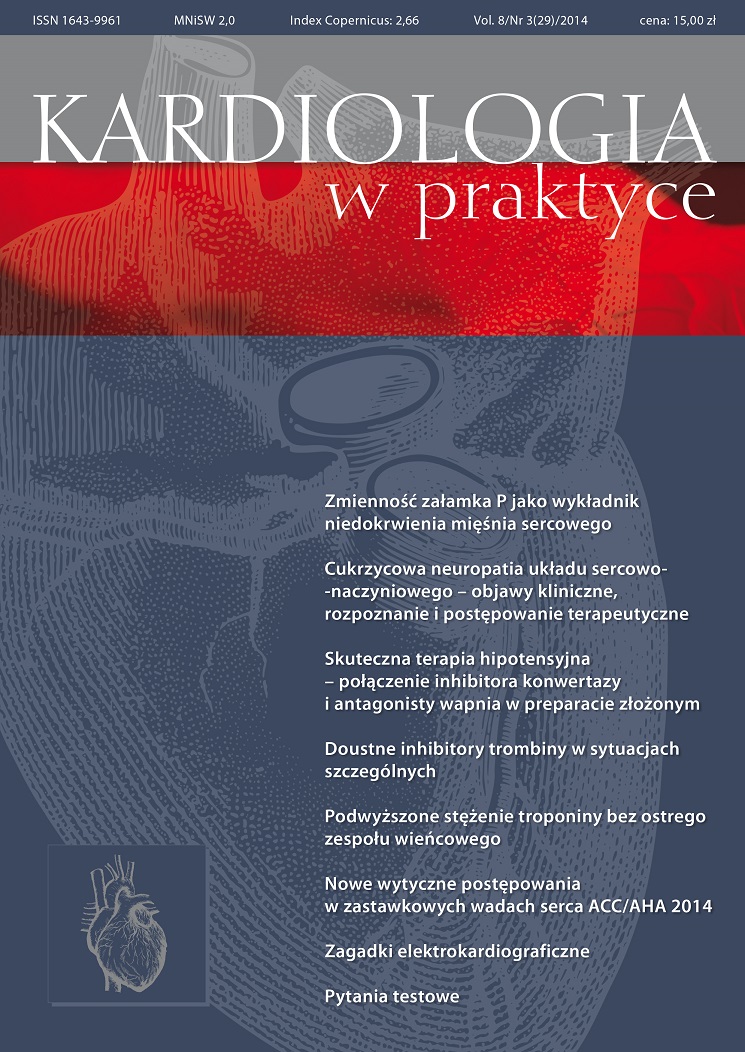Doustne inhibitory trombiny w sytuacjach szczególnych Artykuł przeglądowy
##plugins.themes.bootstrap3.article.main##
Abstrakt
Przez wiele lat antagoniści witaminy K (VKA, vitamin K antagonists) byli jedynymi skutecznymi doustnymi antykoagulantami w leczeniu i prewencji powikłań zakrzepowo-zatorowych. Jednak ich kliniczne zastosowanie było ograniczone przez wiele interakcji z innymi lekami, potrzebę monitorowania terapii oraz wąskie okno terapeutyczne. Z tego względu odpowiedź na leczenie jest zmienna u poszczególnych chorych. Nieprawidłowe użycie tych leków może powodować także powikłania krwotoczne lub zakrzepowo-zatorowe. Ostatnio dynamicznie rozwijającą się grupą leków są nowe doustne antykoagulanty (NOAC). Pozbawione są one niektórych działań ubocznych VKA, a jednocześnie cechują się zbliżoną skutecznością w prewencji powikłań zakrzepowo-zatorowych. Jednym z tych leków jest dabigatran – odwracalny selektywny inhibitor trombiny niemający bezpośredniego wpływu na inne czynniki krzepnięcia. Pomimo że dabigatran stosuje się już od dłuższego czasu, przy podawaniu go należy zachować szczególną ostrożność w niektórych sytuacjach klinicznych. Dotyczy to przede wszystkim powikłań krwotocznych oraz postępowania w przypadku ich wystąpienia. Podobnie należy pamiętać o konieczności ostrożnego prowadzenia terapii u pacjentów w okresie okołooperacyjnym czy też u pacjentów z zaburzeniami funkcji wątroby oraz nerek. Artykuł ten ma na celu przedstawienie właściwego prowadzenia terapii dabigatranem we wspomnianych wyżej sytuacjach klinicznych.
Pobrania
##plugins.themes.bootstrap3.article.details##

Utwór dostępny jest na licencji Creative Commons Uznanie autorstwa – Użycie niekomercyjne – Bez utworów zależnych 4.0 Międzynarodowe.
Copyright: © Medical Education sp. z o.o. This is an Open Access article distributed under the terms of the Attribution-NonCommercial 4.0 International (CC BY-NC 4.0). License (https://creativecommons.org/licenses/by-nc/4.0/), allowing third parties to copy and redistribute the material in any medium or format and to remix, transform, and build upon the material, provided the original work is properly cited and states its license.
Address reprint requests to: Medical Education, Marcin Kuźma (marcin.kuzma@mededu.pl)
Bibliografia
2. You J.J., Singer D.E., Howard P.A. et al.: Antithrombotic therapy for atrial fibrillation: Antithrombotic Therapy and Prevention of Thrombosis, 9th ed.: American College of Chest Physicians Evidence-Based Clinical Practice Guidelines. Chest 2012; 141(2 Suppl.): e531S-e575S.
3. Fawole A., Daw H., Crowther M.: Practical management of bleeding due to the anticoagulants dabigatran, rivaroxaban and apixaban. Cleve Clin. J. Med. 2013; 80(7): 443-451.
4. Heidbuchel H., Verhamme P., Alings M. et al.: EHRA practical guide on the use of new oral anticoagulants in patients with non-valvular atrial fibrillation: executive summary. Eur. Heart J. 2013; 27: 2094-2106.
5. Jeffrey D., Wessler M.D., Laura T. et al.: The P-glycoprotein Transport system and Cardiovascular drugs. J. Am. Coll. Cardiol. 2013; 61: 2495-2502.
6. Pernod G., Albaladejo P., Godier A. et al.: Management of major bleeding complications and emergency surgery in patients on long-term treatment with direct oral anticoagulants, thrombin or factor-Xa inhibitors: Proposals of the Working Group on Perioperative Haemostasis (GIHP) – March 2013. Arch. Cardiovasc. Dis. 2013; 106: 382-393.
7. Connolly S.J., Ezekowitz M.D., Yusuf S. et al.; RE-LY Steering Committee and Investigators: Dabigatran versus warfarin in patients with atrial fibrillation. N. Engl. J. Med. 2009; 361: 1139-1151.
8. Desai J., Kolb J.M., Weitz J.I. et al.: Gastrointestinal bleeding with the new oral anticoagulants – defining the issues and the management strategies. Thromb. Haemost. 2013; 110: 205-212.
9. Abraham N.S., Castillo D.L.: Novel anticoagulants: bleeding risk and management strategies. Curr. Opin. Gastroenterol. 2013; 29(6): 676-683.
10. Spyropoulos A.C., Douketis J.D.: How I treat anticoagulated patients undergoing an elective procedure or surgery. Blood 2012; 120: 2954-2962.
11. Douketis J.D., Spyropoulos A.C., Spencer F.A. et al.: Perioperative management of antithrombotic therapy: Antithrombotic Therapy and Prevention of Thrombosis, 9th ed.: American College of Chest Physicians Evidence-Based Clinical Practice Guidelines. Chest 2012; 141(2 Suppl): e326Se350S999.
12. Camm A.J., Kirchhof P., Lip G.Y. et al.: Guidelines for the management of atrial fibrillation: the Task Force for the Management of Atrial Fibrillation of the European Society of Cardiology (ESC). Europace 2010; 12: 1360-1420.
13. Liew A., Douketis J.: Perioperative management of patients who are receiving a novel oral anticoagulant. Intern. Emerg. Med. 2013; 8: 477-484.
14. Hart R.G., Eikelboom J.W., Brimble K.S. et al.: Stroke Prevention in Atrial Fibrillation Patients with Chronic Kidney Disease. Can. J. Cardiol. 2013; 29(7 Suppl): 71-78.
15. Ng K.P., Edwards N.C., Lip G.Y. et al.: Atrial Fibrillation in CKD: Balancing the Risks and Benefits of Anticoagulation. Am. J. Kidney Dis. 2013; 62(3): 615-632.
16. Hylek E.M., Ko D., Cove C.L.: Gaps in translation from trials to practice: non-vitamin K antagonist oral anticoagulants (NOACs) for stroke prevention in atrial fibrillation. Thromb. Haemost. 2014; 111(5): 783-788.
17. Pruszczyk P., Stepinska J., Banasiak W. et al.: New oral anticoagulants in the prevention of embolic complications in patients with atrial fibrillation. Polish Cardiac Society, Polish Neurological Society and Working Group on Haemostasis of the Polish Society of Haematologists and Transfusiologists consensus statement. Kardiol. Pol. 2012; 9: 979-988.
18. Miesbach W., Seifried E.: New direct oral anticoagulants – current therapeutic options and treatment recommendations for bleeding complications. Thromb. Haemost. 2012; 108(4): 625-632.
19. Thachil J.: Relevance of clotting tests in liver disease. Postgrad. Med. J. 2008; 84(990): 177-181.
20. Deitelzweig S.B., Lin J., Kreilick C. et al.: Warfarin therapy in patients with venous thromboembolism: patterns of use and predictors of clinical outcomes. Adv. Ther. 2010; 27(9): 623-633.
21. Amitrano L., Guardascione M.A., Brancaccio V. et al.: Coagulation disorders in liver disease. Semin. Liver Dis. 2002; 22(1): 83-96.
22. Caldwell S.H., Hoffman M., Lisman T. et al.: Coagulation disorders and hemostasis in liver disease: pathophysiology and critical assessment of current management. Hepatology 2006; 44(4): 1039-1046.
23. Blech S., Ebner T., Ludwig-Schwellinger E. et al.: The metabolism and disposition of the oral direct thrombin inhibitor, dabigatran, in humans. Drug. Metab. Dispos. 2008; 36(2): 386-399.
24. Caldeira D., Barra M., Santos A.T. et al.: Risk of drug-induced liver injury with the new oral anticoagulants: systematic review and meta-analysis. Heart 2014; January 29 [online: doi: 10.1136/heartjnl-2013-305288].
25. Hochtl T., Huber K.: New anticoagulants for the prevention of stroke in atrial fibrillation. Fundam. Clin. Pharmacol. 2012; 26(1): 47-53.
26. Graff J., Harder S.: Anticoagulant Therapy with the Oral Direct Factor Xa Inhibitors Rivaroxaban, Apixaban and Edoxaban and the Thrombin Inhibitor Dabigatran Etexilate in Patients with Hepatic Impairment. Clin. Pharmacokinet. 2013; 52: 243-254.
